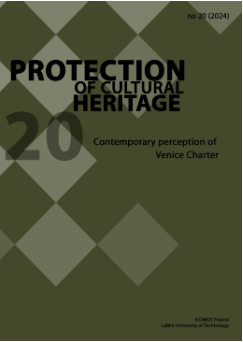Conservation issues and assumptions for the protection of objects of the former KL Auschwitz-Birkenau
Jolanta Banaś-Maciaszczyk
Auschitz-Birkenau Memorial and Museum (Poland)
Rafał Pióro
Auschitz-Birkenau Memorial and Museum (Poland)
https://orcid.org/0000-0002-1797-7307
Abstract
The article presents a scale and challenges of the protection and preservation of the former German Nazi Auschwitz-Birkenau concentration and extermination camp.
The sequence of actions taken in order to preserve the site from the moment of the museum foundation in 1947, through establishing the professional conservation laboratories in 2003, to the first works carried out within the extensive long-term conservation program (Master Plan for Preservation) in the period 2012–2016, has been described in the synthetic and cross-sectional manner.
The authors point to main directions and principles, the rules that were applied by the following generations responsible for preservation of the former camp. They specify also the current conservation guidelines formed on the basis of the experience from the works performed in the period 1947–2002, that were later revised and specified by the team of certified conservators employed by the museum.
The article indicates the most significant events related to the protection and preservation of the former camp and mentions some selected conservation projects that were carried out on the basis of the present conservation guidelines.
Auschwitz is an example which shows that thanks to the early steps taken and later consistently implemented, the authenticity of this place has been successfully maintained. Those actions enabled also to develop mechanisms for long-term planned conservation.
Keywords:
the Auschwitz-Birkenau concentration camp, preservation of the former Auschwitz-Birkenau camp, conservation issues concerning the Auschwitz-Birkenau objects and structuresReferences
Banaś J., Cyrulik E., Papis A., Pióro R., Programy konserwatorskie dla bloków o nr inw. A-2 i A-3, Część pierwsza – Wprowadzenie, Dział Konserwacji PMA-B w Oświęcimiu, 2007.
Google Scholar
Łopuska A., Założenia konserwatorskie dla baraków murowanych na odcinku BI dawnego KL Auschwitz II-Birkenau, Oświęcim 2014.
Google Scholar
Rymaszewski B., Granice ingerencji muzealnej i konserwatorskiej w Muzeum i Miejscu Pamięci Auschwitz [w:] K. Marszałek (red.), Chronić dla przyszłości, Oświęcim 2003.
Google Scholar
Smrek W., Dziesięć lat prac konserwatorskich w Państwowym Muzeum Auschwitz-Birkenau [w:] K. Marszałek (red.) Chronić dla przyszłości, Oświęcim 2003.
Google Scholar
Ustawa z dnia 2 lipca 1947 r. o upamiętnieniu męczeństwa Narodu Polskiego i innych Narodów w Oświęcimiu, Dz. U. Nr 52, poz. 265.
Google Scholar
Authors
Jolanta Banaś-MaciaszczykAuschitz-Birkenau Memorial and Museum Poland
konserwator zabytków. Absolwentka kierunku Konserwacja i Restauracja Dzieł Sztuki
w Instytucie Zabytkoznawstwa i Konserwatorstwa Uniwersytetu Mikołaja Kopernika w Toruniu
oraz Podyplomowych Studiów Konserwacji Zabytków Architektury i Urbanistyki Politechniki
Krakowskiej.
W Państwowym Muzeum Auschwitz-Birkenau od 2004 r, od 2006 r. Kierownik Sekcji
Konserwatorskiej, a następnie od 2009 kierownik Działu Konserwacji. W Muzeum odpowiada za
działania związane z konserwacją wszystkich obiektów zachowanych po KL Auschwitz-Birkenau;
budynków, terenu wraz z zachowaną infrastrukturą, historycznej zieleni a także muzealiów
i archiwaliów.
Authors
Rafał PióroAuschitz-Birkenau Memorial and Museum Poland
https://orcid.org/0000-0002-1797-7307
wicedyrektor Państwowego Muzeum Auschwitz-Birkenau w Oświęcimiu odpowiedzialny m.in. za
zachowanie autentyczności Miejsca Pamięci, zbiory i archiwum; wiceprezes Fundacji Auschwitz-Birkenau.
Ukończył dwa kierunki konserwatorskie na Uniwersytecie Toruńskim (Ochrona Dóbr Kultury
oraz Konserwacja i Restauracja Dzieł Sztuki). W latach 2002/2003 w Państwowym Muzeum Auschwitz-
Birkenau stworzył od podstaw pracownię konserwatorską i został jej kierownikiem. W 2006 roku został
kierownikiem Działu Konserwacji, a w roku 2009 wicedyrektorem Muzeum. Wówczas zainicjował
i współtworzył Globalny Plan Konserwacji dla całego Miejsca Pamięci.
Statistics
Abstract views: 255PDF downloads: 257








